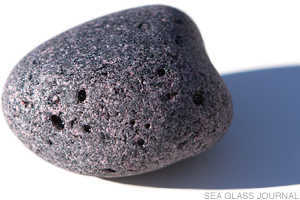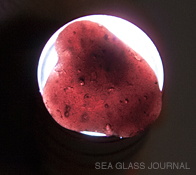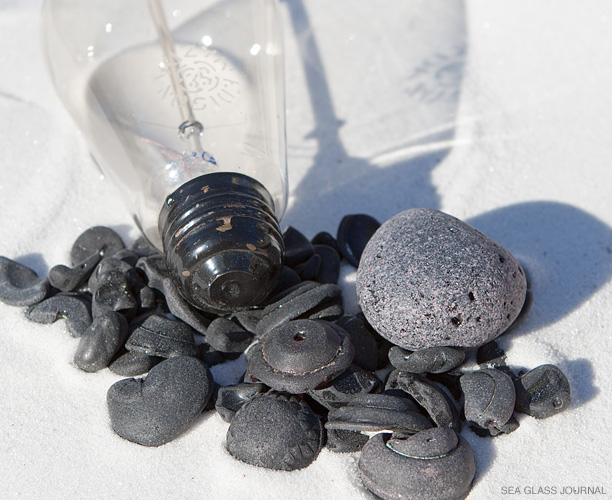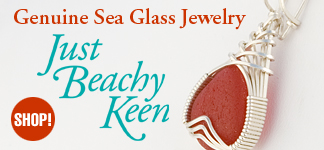The Sea Glass Shard of the Month: MAY 2014
Vitrite Sea Glass from Lake Erie

Sea Glass Specifications:
Color: Black Amethyst
Max Length: 41.7 mm (1.64")
Max Width: 39.9 mm (1.57")
Max Thickness: 25.1 mm (0.99")
Weight: 48.2 grams (1.70 oz)
Estimated Age: Between 65 to 75 Years
For the first month of 2014 we are going to explore the origins of this unusually dark sea glass specimen, found in a particular area of Lake Erie. In this locality, and other areas around the Great Lakes, sea glass is commonly referred to as beach glass as it is found along the lakes rather than coastal waterways.

Thinner shards of vitrite that do allow light to pass through will reveal the true nature of its deep amethyst color.
Facts of Interest
Before the use of vitrite to insulate the contacts, base designs incorporated wood, plaster of Paris or porcelain.
Alfred Swan, the youngest brother of Sir Joseph Swan of early electric incandescent lamp fame, was born in Sunderland, County Durham, England, near the North Sea. This area is now famous to the sea glass collector for the multi-colored sea glass shards originating from the glass factories that operated in the mid-19th and early 20th Centuries.
To see a brief history and the application of vitrite in light bulbs click Vitrite & Light Bulbs.
This specimen in particular is black sea glass (glass that is usually another color like green or brown that is so dark that it appears to be black) that is so dark and thick that light can not pass through it. The true nature of this shard's hue is revealed by the purplish frost on its surface when clean and dry.
This type of glass is called vitrite, a slag glass that is commonly used as a dielectric — an electrical insulator, most prominently used in the base of common incandescent light bulbs. This substance consisted mainly of ground glass along with copious amounts of lead oxide and manganese oxide, the latter being responsible for the dark purple color.
"These pieces can be a bit difficult to find, most people pass them over thinking they are just stones."
One major producer of incandescent light bulbs was General Electric, which had one such plant located on Lake Erie in Conneaut, OH that operated between 1941 and 2008. Along that area of the lake chunks of cobalt[1] or deep amethyst in varying shapes and sizes can be found. It is rumored that in the 1950s and 1960s discarded glass from GE was used as landfill along the shoreline to inhibit beach erosion[2]. This story would certainly explain the abundance of bulbous shards found in that area of Lake Erie.
Marilyn Boyles, owner of Lake Effect Beach Glass mentions "These pieces can be a bit difficult to find, most people pass them over thinking they are just stones. A closer look while beachcombing will lead the eye to a slightly purplish look. That, along with the pitting that is darker in color and glossy looking, gives it away as glass."
Although the sea glass specimen featured here will not allow light to pass through, some thinner shards found will reveal the deep amethyst color when backlit by a strong light source such as the sun or flashlight.
While you may not be able to visit the shores of Lake Erie anytime soon to hunt for this bulbous, dark purple refuse, keep an eye out for the small, cap shaped shards of dark purple glass, whether whole or broken. Millions upon millions of incandescent light bulbs have been produced over the years and many, after no longer being of use, have found their way to an ocean or lake. You will have found yourself some vitrite to add to your collection of sea glass.
REFERENCES:
1. Cobalt blue is another color that insulator caps can have.
2. http://www.lakeerieliving.com/main/articles/treasure_quest_519.aspx

Keep up-to-date on all things sea glass... like us on Facebook!
Sea Glass Journal on Facebook






